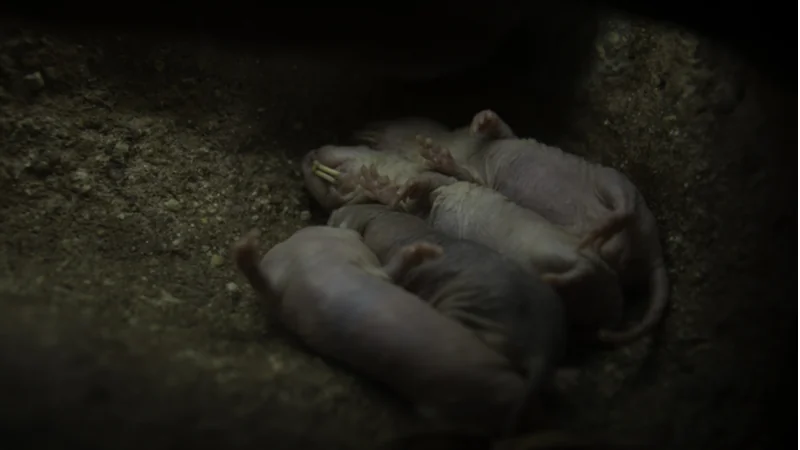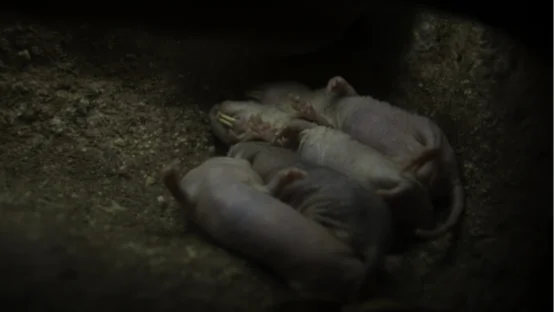Naked mole rats are long-lived rodents famous for their resistance to cancer and sustained healthy lifespan. In a new study published in the Journal of Investigative Dermatology, researchers have shown that the skin of older members of this species is characterized by high expression of longevity-associated and tumor-suppressing genes [1].
Getting under the skin
Skin is the first visual clue we get about a person’s age, which is why a myriad of skin care products and cosmetic procedures are marketed to supposedly make people look young again. In humans, smooth, plump, even-colored skin is associated with youth, whereas dry, droopy, wrinkled skin is an indicator of old age.
Several processes underlie these changes, including a decrease of epidermal thickness (outer skin layer), a decline of specific cell types and dermal volume, and a breakdown of the extracellular matrix components such as collagen and elastin. However, these age-driven skin changes might not be universal among all mammals.
In this study, researchers set to investigate the skin aging of naked mole rats, which could be useful to understand human skin aging. Unlike short-lived rats and mice, naked mole rats are a long-lived species on par with humans. In addition, the genome of naked mole rats shows a greater similarity to the human genome than that of many other rodent species.
On the other hand, a recent study showed that unlike human skin, increased epidermal thickness could be the only difference between young and old naked mole rats [2]. As even young naked mole rats are wrinkly, their subterranean environment lacks damaging UV rays, and their skin is heavily resistant to cancer, it’s hardly surprising that their skin aging differs from ours. Nevertheless, in this study, several common features have been discovered.
Morphological skin changes due to aging
First, the researchers compared the visual appearance and moprhology of the back skin of four young (2- to 4.5-year-old) and three aged (19- to 23-year-old) naked mole rats of both sexes. They observed that the skin of the older animals was thinner due to the reduced epidermal thickness, and it was more translucent and less pigmented.
The aged skin of naked mole rats was also characterized by a reduced proliferation of keratinocytes (the most common skin cell type) and a decreased number of Merkel cells (sensory cells) and pigment-producing melanocytes, which was in line with the observed difference in skin pigmentation between younger and older animals.
Age-associated changes in the skin’s immune cells were also observed. The skin of old naked mole rats decreased in T cells, antigen-presenting cells, and mast cells, and there was an increase in senescent cells.
Age-associated molecular changes in the skin
The researchers then conducted a comparative transcriptomic analysis of the skin of two 4-year-old and two 19-year-old animals. They detected an increased expression of some extracellular matrix remodeling enzymes (Mmp9, Mmp11) and a decrease of collagen genes (Colla1, Colla2) in the old skin. These results were consistent with the previously performed immunostaining experiments.
To get an insight of how naked mole rate skin aging correlates with that of mice and people, the researchers compared the transcriptomic data they obtained with the datasets available for the other two species. Surprisingly, only a small portion of genes showed a similar age-associated expression change in all three species.
A comparison of this study’s transcriptomic data with the Human Aging Genomic Resources and the Cancer Gene Census database revealed that the skin of old naked mole rats increases its expression of such longevity-associated genes as Igfbp3, Igf2bp3, and Ing2 and decreases its expression of cancer-related genes.
None of the longevity-associated and cancer suppressing genes upregulated in the old skin of naked mole rats were elevated in the old skin of mice or humans. This might explain the remarkable resistance of naked mole rats to skin cancer. This should be further validated with a functional analysis of these genes in the naked mole rat along with a comparison to their human homologs.
Abstract
Naked mole rats (NMRs, Heterocephalus glaber) are long-lived mammals that possess a natural resistance to cancer and other age-related pathologies, maintaining a healthy life span for >30 years. Here, using immunohistochemical and RNAseq analyses, we compare skin morphology, cellular composition and global transcriptome signatures between young and aged (3-4 versus 19-23-year-old) NMRs. We demonstrate that similar to human skin, aging in NMRs is accompanied by a decrease of epidermal thickness, keratinocyte proliferation, and a decline in the number of Merkel cells, T-cells, antigen-presenting cells and melanocytes. Similar to human skin aging, expression levels of dermal collagens are decreased, while Mmp-9 and Mmp-11 levels increased in aged versus young NMR skin. RNAseq analyses reveal that in contrast to human or mouse skin aging, the transcript levels of several longevity-associated (Igfbp3, Igf2bp3, Ing2) and tumor-suppressor genes (Btg2, Cdkn1a, Cdkn2c, Dnmt3a, Hic1, Socs3, Sfrp1, Sfrp5, Thbs1, Tsc1, Zfp36) are increased in aged NMR skin. Overall, these data suggest that specific features in the NMR skin aging transcriptome might contribute to the resistance of NMRs to spontaneous skin carcinogenesis and provide a platform for further investigations of NMRs as a model organism for studying the biology and disease resistance of human skin.
Conclusion
This study shows that the morphological changes of the aging skin of the naked mole rat are similar to those of human skin, including the decrease of thickness and increase of senescence. These results seem contradictory to the results obtained in a previous study performed in middle-aged 11-year-old animals [2]. This could be explained by naked mole rat skin aging occurring later in life and being detected in this study.
At the molecular level, the skin aging of naked mole rats differs significantly from human skin aging. Longevity-promoting genes are upregulated, possibly protecting the animal from developing cancer and other age-associated skin pathologies. This could give researchers a clue for further investigations to find methods to truly rejuvenate the skin of people.
Literature
[1] Fatima, I., Chen, G., Botchkareva, N. V., Sharov, A. A., Thornton, D., Wilkinson, H. N., … & Botchkarev, V. A. (2022). Skin Aging in Long-Lived Naked Mole-Rats is Accompanied by Increased Expression of Longevity-Associated and Tumor Suppressor Genes. Journal of Investigative Dermatology.
[2] Savina, A., Jaffredo, T., Saldmann, F., Faulkes, C. G., Moguelet, P., Leroy, C., … & Fontaine, R. H. (2022). Single-cell transcriptomics reveals age-resistant maintenance of cell identities, stem cell compartments and differentiation trajectories in long-lived naked mole-rats skin. Aging (Albany NY), 14(9), 3728.



